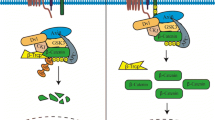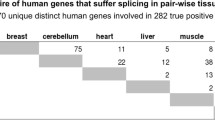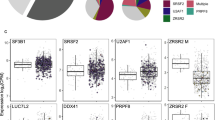Abstract
Medulloblastoma comprises four distinct molecular variants: WNT, SHH, Group 3, and Group 4. We analyzed alternative splicing usage in 14 normal cerebellar samples and 103 medulloblastomas of known subgroup. Medulloblastoma samples have a statistically significant increase in alternative splicing as compared to normal fetal cerebella (2.3-times; P < 6.47E−8). Splicing patterns are distinct and specific between molecular subgroups. Unsupervised hierarchical clustering of alternative splicing events accurately assigns medulloblastomas to their correct subgroup. Subgroup-specific splicing and alternative promoter usage was most prevalent in Group 3 (19.4%) and SHH (16.2%) medulloblastomas, while observed less frequently in WNT (3.2%), and Group 4 (9.3%) tumors. Functional annotation of alternatively spliced genes reveals overrepresentation of genes important for neuronal development. Alternative splicing events in medulloblastoma may be regulated in part by the correlative expression of antisense transcripts, suggesting a possible mechanism affecting subgroup-specific alternative splicing. Our results identify additional candidate markers for medulloblastoma subgroup affiliation, further support the existence of distinct subgroups of the disease, and demonstrate an additional level of transcriptional heterogeneity between medulloblastoma subgroups.





Similar content being viewed by others
References
Abouantoun TJ, MacDonald TJ (2009) Imatinib blocks migration and invasion of medulloblastoma cells by concurrently inhibiting activation of platelet-derived growth factor receptor and transactivation of epidermal growth factor receptor. Mol Cancer Ther 8(5):1137–1147
Alló M, Buggiano V, Fededa JP, Petrillo E, Schor I et al (2009) Control of alternative splicing through siRNA-mediated transcriptional gene silencing. Nat Struct Mol Biol 16(7):717–724
Bark C, Bellinger FP, Kaushal A, Mathews JR, Partridge LD et al (2004) Developmentally regulated switch in alternatively spliced SNAP-25 isoforms alters facilitation of synaptic transmission. J Neurosci 24(40):8796–8805
Bartel F, Taubert H, Harris LC (2002) Alternative and aberrant splicing of MDM2 mRNA in human cancer. Cancer Cell 2(1):9–15
Bhatia B, Northcott PA, Hambardzumyan D, Govindarajan B, Brat DJ et al (2009) Tuberous sclerosis complex suppression in cerebellar development and medulloblastoma: separate regulation of mammalian target of rapamycin activity and p27 Kip1 localization. Cancer Res 69(18):7224–7234
Bruinsma SP, Baranski TJ (2007) Beta2-chimaerin in cancer signaling: connecting cell adhesion and MAP kinase activation. Cell Cycle 6(20):2440–2444
Bueren AO, von Hoff K, Pietsch T, Gerber NU, Warmuth-Metz M et al (2011) Treatment of young children with localized medulloblastoma by chemotherapy alone: results of the prospective, multicenter trial HIT 2000 confirming the prognostic impact of histology. Neuro Oncol 13(6):669–679
Buonamici S, Williams J, Morrissey M, Wang A, Guo R et al (2010) Interfering with resistance to smoothened antagonists by inhibition of the PI3K pathway in medulloblastoma. Sci Transl Med 2(51): 51ra70
Cho Y-J, Tsherniak A, Tamayo P, Santagata S, Ligon A et al (2011) Integrative genomic analysis of medulloblastoma identifies a molecular subgroup that drives poor clinical outcome. J Clin Oncol 29(11):1424–1430
Cline MS, Smoot M, Cerami E, Kuchinsky A, Landys N et al (2007) Integration of biological networks and gene expression data using Cytoscape. Nat Protoc 2(10):2366–2382
David CJ, Manley JL (2010) Alternative pre-mRNA splicing regulation in cancer: pathways and programs unhinged. Genes Dev 24(21):2343–2364
Dubuc AM, Northcott PA, Mack S, Witt H, Pfister S et al (2010) The genetics of pediatric brain tumors. Curr Neurol Neurosci Rep 10(3):215–223
Eberhart CG (2011) Molecular diagnostics in embryonal brain tumors. Brain Pathol 21(1):96–104
Ellison DW (2010) Childhood medulloblastoma: novel approaches to the classification of a heterogeneous disease. Acta Neuropathol 120(3):305–316
Evans HK, Weidman JR, Cowley DO, Jirtle RL (2005) Comparative phylogenetic analysis of blcap/nnat reveals eutherian-specific imprinted gene. Mol Biol Evol 22(8):1740–1748
Fan W, Khalid N, Hallahan AR, Olson JM, Zhao LP (2006) A statistical method for predicting splice variants between two groups of samples using GeneChip expression array data. Theor Biol Med Model 3:19
Ferretti E, Di Marcotullio L, Gessi M, Mattei T, Greco A et al (2006) Alternative splicing of the ErbB-4 cytoplasmic domain and its regulation by hedgehog signaling identify distinct medulloblastoma subsets. Oncogene 25(55):7267–7273
French PJ, Peeters J, Horsman S, Duijm E, Siccama I et al (2007) Identification of differentially regulated splice variants and novel exons in glial brain tumors using exon expression arrays. Cancer Res 67(12):5635–5642
Gardina PJ, Clark TA, Shimada B, Staples MK, Yang Q et al (2006) Alternative splicing and differential gene expression in colon cancer detected by a whole genome exon array. BMC Genomics 7:325
Gibson P, Tong Y, Robinson G, Thompson MC, Currle DS et al (2010) Subtypes of medulloblastoma have distinct developmental origins. Nature 468(7327):1095–1099
Gilbertson RJ (2011) Finding the perfect partner for medulloblastoma prognostication. J Clin Oncol 29(29):3841–3842
Hallahan AR, Pritchard JI, Chandraratna RAS, Ellenbogen RG, Geyer JR et al (2003) BMP-2 mediates retinoid-induced apoptosis in medulloblastoma cells through a paracrine effect. Nat Med 9(8):1033–1038
Hilmi C, Guyot M, Pagès G (2012) VEGF spliced variants: possible role of anti-angiogenesis therapy. J Nucleic Acids 2012:162692
Ingham PW (1998) The patched gene in development and cancer. Curr Opin Genet Dev 8(1):88–94
Kai M, Yasuda S, Imai S-I, Kanoh H, Sakane F (2007) Tyrosine phosphorylation of beta2-chimaerin by Src-family kinase negatively regulates its Rac-specific GAP activity. Biochim Biophys Acta 1773(9):1407–1415
Katayama S, Tomaru Y, Kasukawa T, Waki K, Nakanishi M et al (2005) Antisense transcription in the mammalian transcriptome. Science 309(5740):1564–1566
Kool M, Koster J, Bunt J, Hasselt NE, Lakeman A et al (2008) Integrated genomics identifies five medulloblastoma subtypes with distinct genetic profiles, pathway signatures and clinicopathological features. PloS one 3(8):e3088
Kwan T, Benovoy D, Dias C, Gurd S, Serre D et al (2007) Heritability of alternative splicing in the human genome. Genome Res 17(8):1210–1218
Leung T, How BE, Manser E, Lim L (1994) Cerebellar beta 2-chimaerin, a GTPase-activating protein for p21 ras-related rac is specifically expressed in granule cells and has a unique N-terminal SH2 domain. J Biol Chem 269(17):12888–12892
MacDonald TJ, Brown KM, LaFleur B, Peterson K, Lawlor C et al (2001) Expression profiling of medulloblastoma: PDGFRA and the RAS/MAPK pathway as therapeutic targets for metastatic disease. Nat Genet 29(2):143–152
Maere S, Heymans K, Kuiper M (2005) BiNGO: a Cytoscape plugin to assess overrepresentation of gene ontology categories in biological networks. Bioinformatics 21(16):3448–3449
Mata MD, Alonso CR, Fededa JP, Pelisch F, Cramer P et al (2003) A slow RNA polymerase II affects alternative splicing in vivo. Mol Cell 12(2):525–532
Medrihan L, Rohlmann A, Fairless R, Andrae J, Döring M et al (2009) Neurobeachin, a protein implicated in membrane protein traffic and autism, is required for the formation and functioning of central synapses. J Physiol 587(Pt 21):5095–5106
Menghi F, Jacques TS, Barenco M, Schwalbe EC, Clifford SC et al (2011) Genome-wide analysis of alternative splicing in medulloblastoma identifies splicing patterns characteristic of normal cerebellar development. Cancer Res 71(6):2045–2055
Modrek B, Lee C (2002) A genomic view of alternative splicing. Nat Genet 30(1):13–19
Morrissy AS, Morin RD, Delaney A, Zeng T, McDonald H et al (2009) Next-generation tag sequencing for cancer gene expression profiling. Genome Res 19(10):1825–1835
Morrissy AS, Griffith M, Marra MA (2011) Extensive relationship between antisense transcription and alternative splicing in the human genome. Genome Res 21(8):1203–1212
Nagao K, Togawa N, Fujii K, Uchikawa H, Kohno Y et al (2005) Detecting tissue-specific alternative splicing and disease-associated aberrant splicing of the PTCH gene with exon junction microarrays. Hum Mol Genet 14(22):3379–3388
Nakajima A, Nishimura K, Nakaima Y, Oh T, Noguchi S et al (2009) Cell type-dependent proapoptotic role of Bcl2L12 revealed by a mutation concomitant with the disruption of the juxtaposed Irf3 gene. Proc Natl Acad Sci USA 106(30):12448–12452
Nilsen TW, Graveley BR (2010) Expansion of the eukaryotic proteome by alternative splicing. Nature 463(7280):457–463
Northcott PA, Fernandez-L A, Hagan JP, Ellison DW, Grajkowska W et al (2009) The miR-17/92 polycistron is up-regulated in sonic hedgehog-driven medulloblastomas and induced by N-myc in sonic hedgehog-treated cerebellar neural precursors. Cancer Res 69(8):3249–3255
Northcott PA, Hielscher T, Dubuc A, Mack S, Shih D et al (2011) Pediatric and adult sonic hedgehog medulloblastomas are clinically and molecularly distinct. Acta Neuropathol 122(2):231–240
Northcott PA, Korshunov A, Witt H, Hielscher T, Eberhart CG et al (2011) Medulloblastoma comprises four distinct molecular variants. J Clin Oncol 29(11):1408–1414
Pfaff E, Remke M, Sturm D, Benner A, Witt H et al (2010) TP53 mutation is frequently associated with CTNNB1 mutation or MYCN amplification and is compatible with long-term survival in medulloblastoma. J Clin Oncol 28(35):5188–5196
Pfister SM, Korshunov A, Kool M, Hasselblatt M, Eberhart C et al (2010) Molecular diagnostics of CNS embryonal tumors. Acta Neuropathol 120(5):553–566
Pons S, Trejo JL, Martínez-Morales JR, Martí E (2001) Vitronectin regulates Sonic hedgehog activity during cerebellum development through CREB phosphorylation. Development 128(9):1481–1492
Raffel C (2004) Medulloblastoma: molecular genetics and animal models. Neoplasia 6(4):310–322
Remke M, Hielscher T, Korshunov A, Northcott PA, Bender S et al (2011) FSTL5 is a marker of poor prognosis in non-WNT/non-SHH medulloblastoma. J Clin Oncol 29(29):3852–3861
Rudin CM, Hann CL, Laterra J, Yauch RL, Callahan CA et al (2009) Treatment of medulloblastoma with hedgehog pathway inhibitor GDC-0449. N Engl J Med 361(12):1173–1178
Shearwin KE, Callen BP, Egan JB (2005) Transcriptional interference—a crash course. Trends Genet 21(6):339–345
Shendure J, Church GM (2002) Computational discovery of sense–antisense transcription in the human and mouse genomes. Genome Biol 3(99): RESEARCH0044
Storrs CH, Silverstein SJ (2007) PATJ, a tight junction-associated PDZ protein, is a novel degradation target of high-risk human papillomavirus E6 and the alternatively spliced isoform 18 E6. J Virol 81(8):4080–4090
Thompson MC, Fuller C, Hogg TL, Dalton J, Finkelstein D et al (2006) Genomics identifies medulloblastoma subgroups that are enriched for specific genetic alterations. J Clin Oncol 24(12):1924–1931
Tijink BM, Buter J, de Bree R, Giaccone G, Lang MS et al (2006) A phase I dose escalation study with anti-CD44v6 bivatuzumab mertansine in patients with incurable squamous cell carcinoma of the head and neck or esophagus. Clin Cancer Res 12(20 Pt 1):6064–6072
Tsang WH, Shek KF, Lee TY, Chow KL (2009) An evolutionarily conserved nested gene pair—Mab21 and Lrba/Nbea in metazoan. Genomics 94(3):177–187
Uchikawa H, Toyoda M, Nagao K, Miyauchi H, Nishikawa R et al (2006) Brain- and heart-specific Patched-1 containing exon 12b is a dominant negative isoform and is expressed in medulloblastomas. Biochem Biophys Res Commun 349(1):277–283
Wang ET, Sandberg R, Luo S, Khrebtukova I, Zhang L et al (2008) Alternative isoform regulation in human tissue transcriptomes. Nature 456(7221):470–476
Wang Z, Burge CB (2008) Splicing regulation: from a parts list of regulatory elements to an integrated splicing code. RNA 14(5):802–813
Ward AJ, Cooper TA (2009) The pathobiology of splicing. J Pathol 220(2):152–163
Wei J, Zaika E, Zaika A (2012) p53 family: role of protein isoforms in human cancer. J Nucleic Acids 2012:687359
Werbowetski-Ogilvie TE, Seyed Sadr M, Jabado N, Angers-Loustau A, Agar NYR et al (2006) Inhibition of medulloblastoma cell invasion by Slit. Oncogene 25(37):5103–5112
Xin D, Hu L, Kong X (2008) Alternative promoters influence alternative splicing at the genomic level. PloS one 3(6):e2377
Yang Z-J, Ellis T, Markant SL, Read T-A, Kessler JD et al (2008) Medulloblastoma can be initiated by deletion of Patched in lineage-restricted progenitors or stem cells. Cancer Cell 14(2):135–145
Zhang C, Li H-R, Fan J-B, Wang-Rodriguez J, Downs T et al (2006) Profiling alternatively spliced mRNA isoforms for prostate cancer classification. BMC Bioinforma 7:202
Zhu H, Lo H-W (2010) The human glioma-associated oncogene homolog 1 (GLI1) family of transcription factors in gene regulation and diseases. Curr Genomics 11(4):238–245
Author information
Authors and Affiliations
Corresponding author
Additional information
A. M. Dubuc and A. S. Morrissy contributed equally to this work.
Electronic supplementary material
Below is the link to the electronic supplementary material.
Rights and permissions
About this article
Cite this article
Dubuc, A.M., Morrissy, A.S., Kloosterhof, N.K. et al. Subgroup-specific alternative splicing in medulloblastoma. Acta Neuropathol 123, 485–499 (2012). https://doi.org/10.1007/s00401-012-0959-7
Received:
Revised:
Accepted:
Published:
Issue Date:
DOI: https://doi.org/10.1007/s00401-012-0959-7




